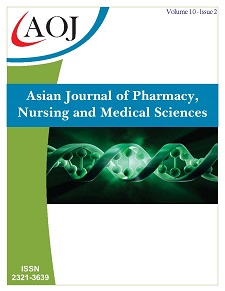Logistics Support for the Ambulance Services at Industrial City Qatar
DOI:
https://doi.org/10.24203/ajpnms.v10i1.6947Keywords:
Ambulance services, Ambulance nurses, Paramedics, Stock on hand, stock consumed report, Point – reorder.Abstract
In order to plan for logistics needs, data regarding the availability of logistics and consumption of logistics is required. Disposable logistics needs are adjusted to meet the minimum standards required by the ambulance unit, both for medicine and supplies. AIM: We are conducting this research mainly for field experience in analyzing ambulance logistics systems at Industrial City locations in Qatar as well as for referral purposes and emergency response purposes. Method: Logistics data reports will provide information and facilitate decision-making at various levels of detail. Result: Logistics support for ambulance services consisted of the following activities: (1). Presenting stock inventory report; (2) Predicting logistics availability; (3) Reporting estimation size of logistics; and (4) Reporting analysis stock availability. Conclusion: A logistics information system for Ambulance services can be seen in the fact that it provides decision-makers with information for the purposes of procurement, purchasing, storage, and distribution of logistics to users. Recommendations: The availability of a logistics information system, which will increase the capacity of ambulance services, is expected to improve the capacity.
References
Ahmed S. “Seeking Information from the Lips of People”: oral history in the archives of Qatar and the Gulf region. Arch Sci. 2018;18(3):225-240. doi:10.1007/s10502-018-9293-8
Kogbara RB, Yiming W, Iyengar SR, et al. Recycling industrial biosludge for buffel grass production in Qatar: Impact on soil, leachate and plant characteristics. Chemosphere. 2020;247:125886. doi:https://doi.org/10.1016/j.chemosphere.2020.125886
O’Cathain A, Jacques R, Stone T, Turner J. Why do ambulance services have different non-transport rates? A national cross sectional study. PLoS One. 2018;13(9):1-20. doi:10.1371/journal.pone.0204508
Reuter-Oppermann M, van den Berg PL, Vile JL. Logistics for Emergency Medical Service systems. Heal Syst. 2017;6(3):187-208. doi:10.1057/s41306-017-0023-x
Gunawan D. Fishbone Analysis of Handover Communication Methods in Emergency Departmentarmy Hospital in Jakarta. Int J Nurs Heal Serv. 2018;1(1):75-82.
Picarillo AP. Introduction to quality improvement tools for the clinician. J Perinatol. 2018;38(7):929-935. doi:10.1038/s41372-018-0100-4
Kourentzes N, Trapero JR, Barrow DK. Optimising forecasting models for inventory planning. Int J Prod Econ. 2020;225:107597. doi:https://doi.org/10.1016/j.ijpe.2019.107597
Inegbedion H, Eze S, Asaleye A, Lawal A. Inventory management and organisational efficiency. J Soc Sci Res. 2019;5(3):756-763. doi:10.32861/jssr.53.756.763
Downloads
Published
Issue
Section
License
Copyright (c) 2022 Sobur Setiaman, Sukartana, Agung Purnomo, Eko Murdianto, Novita Anna, Agusta Dian Ellina, Yuly Peristiowati

This work is licensed under a Creative Commons Attribution-NoDerivatives 4.0 International License.
- Papers must be submitted on the understanding that they have not been published elsewhere (except in the form of an abstract or as part of a published lecture, review, or thesis) and are not currently under consideration by another journal published by any other publisher.
- It is also the authors responsibility to ensure that the articles emanating from a particular source are submitted with the necessary approval.
- The authors warrant that the paper is original and that he/she is the author of the paper, except for material that is clearly identified as to its original source, with permission notices from the copyright owners where required.
- The authors ensure that all the references carefully and they are accurate in the text as well as in the list of references (and vice versa).
- Authors retain copyright and grant the journal right of first publication with the work simultaneously licensed under a Attribution-NonCommercial 4.0 International that allows others to share the work with an acknowledgement of the work's authorship and initial publication in this journal.
- Authors are able to enter into separate, additional contractual arrangements for the non-exclusive distribution of the journal's published version of the work (e.g., post it to an institutional repository or publish it in a book), with an acknowledgement of its initial publication in this journal.
- Authors are permitted and encouraged to post their work online (e.g., in institutional repositories or on their website) prior to and during the submission process, as it can lead to productive exchanges, as well as earlier and greater citation of published work (See The Effect of Open Access).
- The journal/publisher is not responsible for subsequent uses of the work. It is the author's responsibility to bring an infringement action if so desired by the author.


